Watford Junction railway station
Watford Junction is a railway station that serves Watford, Hertfordshire. The station is on the West Coast Main Line (WCML), 17 miles 34 chains from London Euston[4] and the Abbey Line, a branch line to St Albans. Journeys to London take between 16 and 52 minutes depending on the service used: shorter times on fast non-stop trains and slower on the stopping Watford DC line services. Trains also run to Clapham Junction and East Croydon via the West London Line. The station is a major hub for local bus services and the connecting station for buses to Warner Bros. Studio Tour London – The Making of Harry Potter. The station is located north of a viaduct over the Colne valley and immediately south of Watford Tunnel.
| Watford Junction | |
|---|---|
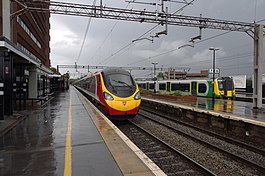 | |
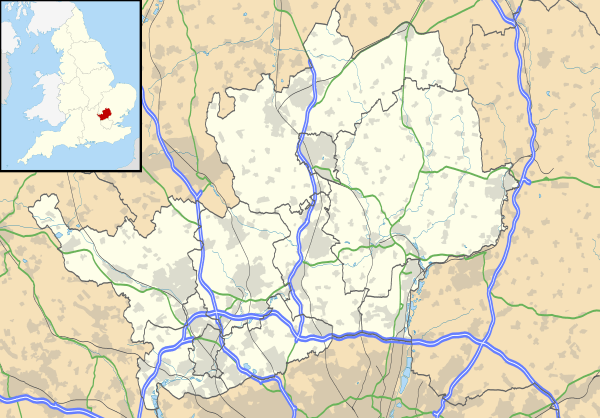 Watford Junction Location of Watford Junction in Hertfordshire | |
| Location | Watford |
| Local authority | Borough of Watford |
| Managed by | London Northwestern Railway |
| Owner | Network Rail |
| Station code | WFJ |
| DfT category | B |
| Number of platforms | 10 |
| Accessible | Yes[1] |
| Fare zone | A |
| National Rail annual entry and exit | |
| 2014–15 | |
| – interchange | |
| 2015–16 | |
| – interchange | |
| 2016–17 | |
| – interchange | |
| 2017–18 | |
| – interchange | |
| 2018–19 | |
| – interchange | |
| Key dates | |
| 20 July 1837 | Original station - Watford - opened.[3] |
| 5 May 1858 | Station relocated and renamed as Watford Junction[3] |
| 1909 | Rebuilt |
| 1980s | Refurbished throughout |
| Other information | |
| External links | |
| WGS84 | 51.6635°N 0.3958°W |
History

_p073_-_Viaduct_over_the_River_Colne_near_Watford.jpg)
The first railway station to open in Watford was situated on the north side of St Albans Road, approximately 200 metres (220 yd) further up the line from the present-day station. This small, single-storey red-brick building was built 1836-7 when the first section of the London and Birmingham Railway (L&BR) was opened between London and Boxmoor. The station provided first and second-class waiting rooms, a departure yard, a carriage shed and engine house. The platforms were situated in a deep cutting which was accessed via a staircase.[5] In its 21 years of operation it also served as a station for royalty; in the short period when the Dowager Queen Adelaide was resident at Cassiobury House (c.1846-49), this station was remodelled to provide her with a royal waiting room, and it was also reportedly used by Queen Victoria and Prince Albert on a trip to visit Sir Robert Peel in November 1843, when they travelled by road from Windsor Castle to take a train from Watford to Tamworth.[6] The old station closed when it was replaced by a new, larger station, which opened on 5 May 1858. The new Watford Junction station was located south of St Albans Road in order to accommodate the newly constructed branch line to St Albans. The junction station was rebuilt in 1909, and was extensively redeveloped in the 1980s. The Grade-II-listed Old Station House still stands at 147A St Albans Road, a rare surviving example of architecture from the beginning of the railway age, and today the building is occupied by a second-hand car dealership.[7]
In 1862, the Watford and Rickmansworth Railway opened a route from Watford to Rickmansworth (Church Street). Now mostly closed, this route began by running south and west to a more central station on Watford's High Street, which remains in use.
From 1846, the L&BR was absorbed into the London and North Western Railway (LNWR) and Watford Junction was now run by this large, ambitious company. Seeking to compete with local buses and trams, the LNWR built an additional suburban line from Euston to Watford in the early years of the 20th century, now known as the Watford DC Line. This veered away from the main line at Bushey to loop around Watford to pass through the High Street station. A second suburban branch line was also built from High Street west towards Croxley Green to serve new housing developments in that area. Both branches were later electrified as part of this improvement plan, on the same DC three-rail system. The Rickmansworth branch was connected to the Main Line via two through platforms with a junction to the north; these platforms have since been partly built over and their remaining southern sections form part of the present DC lines terminus. At one time tube-style trains were used on the branches to counter the low voltage caused by the lack of a sub-station near Rickmansworth.
The Bakerloo line was extended to Watford Junction in 1917, giving a shared service north of Willesden Junction with the main line electric trains which served Euston and Broad Street stations. However, since 1982[8] the line north of Harrow & Wealdstone has only been served by what is now the London Overground service from Euston station; this service uses these DC lines for its "all stations" local service.
Oyster Card capability was extended to this station on 11 November 2007 on both the London Overground and Southern. It was extended to London Midland services on 18 November 2007. However, the station is outside London fare zones 1–9 and special fares apply.
With the electrification of the entire West London Line in the 1990s, it became practical to run services from Watford Junction to Clapham Junction, allowing passengers to cross London without changing trains. Southern rail now operate an hourly service from Milton Keynes through Watford to East Croydon with connections to Brighton and Gatwick.
There is a well known expression "North of Watford" which is used to mean the north of England, especially a place remote from London.[9] The alternative variant phrase "North of Watford Junction" was used with similar meaning in the past, referring to Watford Junction railway station.[10][11][12] The expression reflects the station's position as the last urban stop on the main railway line out of London to the north of England. In more recent years it has been suggested that the phrase references Watford Gap services on the M1,[13] however the original saying was in existence well before its opening in 1959.[14][15][16]
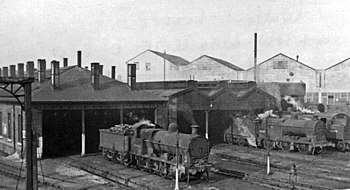
Motive power depot
The LNWR built a locomotive depot at the station in 1856, which was replaced by a larger building in 1872, and further enlarged in 1890. It was closed by British Railways in March 1965.[17]
Redevelopment
In 1984 the Victorian station buildings were demolished and the station was rebuilt in a modern architectural style with a travel centre and a large office block above the station which is occupied by the lorry and bus manufacturing company Iveco. Some 19th-century waiting rooms survived, but were finally demolished in 1987.[18] To enlarge the car park and provide more space, the St. Albans branch line was realigned northwards, with the original St. Albans platforms becoming a single terminating bay now mostly used by Southern services.
The station forecourt was extensively remodelled in 2013; the horseshoe-shaped taxi rank was moved to the side of the building, creating a larger pedestrian area in front of the station entrance, and the bus station enlarged. Due to problems with the road layout, buses were unable to gain access to the bus station, and there were problems with access to the relocated car park. London Northwestern Railway are considering revising the design.[19]
Further redevelopment of the station and its surroundings is planned for the next 10 years. They may be delayed because the redevelopment of Watford Junction has been placed within the Pre-Qualification pool of proposed schemes by the Department for Transport.
Accidents and incidents
1954 accident
| 1954 Watford Junction derailment | |||||||||||||||||||||||||||
|---|---|---|---|---|---|---|---|---|---|---|---|---|---|---|---|---|---|---|---|---|---|---|---|---|---|---|---|
| |||||||||||||||||||||||||||
On 3 February 1954, an express passenger train became derailed in Watford Tunnel due to a broken rail. The last three carriages became divided from the train as it entered the station. One of them ended up on the platform. A passing express passenger train grazed the wreckage but only received minor damage. Fifteen people were injured.[20]
1975 accident
| 1975 Watford Junction rail crash | |||||||||||||||||||||||||||
|---|---|---|---|---|---|---|---|---|---|---|---|---|---|---|---|---|---|---|---|---|---|---|---|---|---|---|---|
| |||||||||||||||||||||||||||
On 23 January 1975, an express train from Manchester to Euston derailed just south of Watford Junction after striking some stillages that had fallen on to the track. It then collided with a sleeper service from Euston to Glasgow. The driver of the Manchester train was killed, and eight passengers and three railway staff injured. The stillages had fallen from a Ford company goods train that had passed the station a few minutes earlier, conveying car parts from Dagenham to Halewood. Although the wagons of the goods train were sealed on departure from Dagenham, three were found to have open doors when the train was inspected after the accident. The official enquiry ruled that the doors had been forced by thieves or vandals, probably when the train was standing at Gospel Oak.[21]
1996 accident
In August 1996, a Class 321 passenger train operated by Network SouthEast passed a signal at danger. An empty Class 321 coaching stock train collided with the stationary passenger train approximately 700 m south of Watford Junction.
2014 incident
On 26 October 2014, a Class 350 electric multiple unit on the 06:42 service from Milton Keynes Central to London Euston, operated by London Midland struck the door of a lineside equipment cabinet and suffered damage to a set of doors; however, no one was killed or injured. The RAIB investigated the incident, and concluded that the lineside cabinet door had not been properly secured during maintenance work the previous night. The investigation also noted that the maintenance crew were likely suffering from fatigue due to a pattern of consistent night-shift work, regular overtime, and short-term sleep deprivation.[22]
2016 accident
On 16 September 2016, Class 350 electric multiple unit 350 264 collided with a landslide, caused by heavy rain the previous night, at the entrance of the Watford Tunnel and derailed. Class 350 unit 350 233 then collided with the derailed train. Two injuries were reported, and trains were disrupted for three days.[23][24]
Station masters
- W. Austin 1852 - 1880
- Alfred Willis Briggs 1883 - 1885 (formerly station master at Banbury)
- Edward Brook 1885 - 1889
- George Tuley 1889 - 1898[25] (afterwards station master at Rugby)
- Frederick Arthur Hawkins 1898 - 1902 (afterwards station master at Rugby)
- William Hedge 1902 - 1908[26] (afterwards station master at Rugby)
- James Glass 1908 - 1914
- E.W. Cross 1914 - 1929[27]
- S. Bunker 1929 - ???? (formerly station master at Wembley (for 3 weeks))
- T. Finch ???? - 1943[28] (afterwards station master at Birmingham New Street)
- G. H. Rogers 1943 - 1944[29] (afterwards station master at Nottingham)
- Frank Shelley 1944 - 1946[30] (afterwards station master at Carlisle)
- F.T. Hawkins 1946 - 1947
- John Ellwood 1947 - 1951[31] (formerly station master Barrow in Furness)
- A. Stabler ca. 1962 - 1965
- J. Bates 1965 - ???? (formerly station master at Bricket Wood)
Services
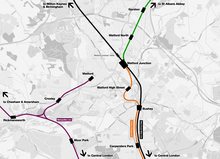
The station is staffed by dispatch staff for London Northwestern Railway; London Overground also maintain a traincrew depot here. London Overground use only platforms 1-4 but also have a link onto platform 6 to be used for stock movements via the WCML to/from London Euston.
Off peak weekday service in trains per hour is:[32]
London Overground
- 4tph to London Euston via the Watford DC line
Southern
- 1tph to Milton Keynes Central
- 1tph to East Croydon
London Northwestern Railway
- 5tph to London Euston
- 2tph to Tring
- 1tph to Milton Keynes Central
- 1tph to Rugeley Trent Valley via Birmingham New Street
- 1tph to Liverpool Lime Street via Birmingham New Street
- 1tph to St Albans Abbey
Avanti West Coast
- 1tph to Birmingham New Street
- 1tph to London Euston (set down only)
Caledonian Sleeper
- 1tpd to Aberdeen/Inverness/Fort William (pick up only)
- 1tpd to Glasgow Central/Edinburgh Waverley
- 1tpd to London Euston (set down only)
| Preceding station | Following station | |||
|---|---|---|---|---|
| Terminus | Watford DC Line | towards Euston |
||
| Crewe | Caledonian Sleeper Highland Caledonian Sleeper (northbound only) |
London Euston | ||
| Carlisle | Caledonian Sleeper Lowland Caledonian Sleeper |
London Euston | ||
| Milton Keynes Central | London Northwestern Railway London - Crewe/Birmingham |
London Euston | ||
| Kings Langley or Hemel Hempstead |
London Northwestern Railway London-Tring/Milton Keynes Central/Northampton/Birmingham |
Bushey or Harrow & Wealdstone or London Euston | ||
| Watford North | London Northwestern Railway Abbey Line |
Terminus | ||
| Hemel Hempstead | Southern West London Route |
Harrow & Wealdstone | ||
| Milton Keynes Central or Rugby or Coventry |
Avanti West Coast London-West Midlands |
London Euston | ||
| Milton Keynes Central or Rugby |
Avanti West Coast West Coast Main Line |
London Euston | ||
| Rugby or Coventry |
Avanti West Coast London Euston-Shrewsbury |
London Euston | ||
| Historical railways | ||||
| Preceding station | Following station | |||
| Terminus | Bakerloo line (1917-1982) | towards Elephant & Castle |
||
| Terminus | British Rail Rickmansworth Branch |
Watford High Street | ||
| Terminus | Network SouthEast Croxley Green Branch |
Watford High Street | ||
Crossrail
Network Rail's July 2011 London & South East Route Utilisation Strategy (RUS) recommended diverting West Coast Main Line (WCML) services from stations between London and Milton Keynes Central away from Euston, to Crossrail via Old Oak Common, to free up capacity at Euston for High Speed 2. This would provide a direct service from the WCML to the Shenfield, Canary Wharf and Abbey Wood, release London Underground capacity at Euston, make better use of Crossrail's capacity west of Paddington, and improve access to Heathrow Airport from the north.[33] Under this scheme, all Crossrail trains would continue west of Paddington, instead of some of them terminating there. They would serve Heathrow Airport (10 tph) and stations to Maidenhead and Reading (6 tph).[34]
In August 2014, a statement by the transport secretary Patrick McLoughlin indicated that the government was actively evaluating the extension of Crossrail as far as Tring, with potential Crossrail stops at Harrow & Wealdstone, Watford Junction, Hemel Hempstead and Berkhamsted. The extension would relieve some pressure from London Underground and London Euston station while also increasing connectivity. Conditions to the extension are that any extra services would not affect the planned service pattern for confirmed routes, as well as affordability.[35][36]
Platforms


Platform Usage:
- Platforms 1-4: Bay platforms for the three trains per hour London Overground Service (Watford DC Line) to London Euston calling at all stations.
(Platform 5 was used by the Bakerloo line services of the London Underground until 1982, and removed as part of the subsequent major rebuild)
- Platform 6 (Down Fast): For the hourly Avanti West Coast service to Birmingham New Street, hourly Avanti West Coast service to Glasgow Central or Edinburgh (alternating), and fast London Northwestern Railway services northbound.
- Platform 7 (Up Fast): For fast London Northwestern Railway services to London Euston and Avanti services only to set down.
- Platform 8 (Down Slow): For slow and semi-fast London Northwestern Railway services northbound and Southern services to Milton Keynes from East Croydon via Clapham Junction, Balham, Selhurst and Kensington Olympia
- Platform 9 (Up Slow): For slow, semi-fast and fast London Northwestern Railway services to London Euston, and Southern services to East Croydon via Kensington Olympia, Selhurst, Balham and Clapham Junction.
- Platform 10: For terminating Southern services to and from Kensington Olympia and Clapham Junction in peak hours and on Sundays. There are additional terminating services to and from East Croydon, Balham, Selhurst and South Croydon on weekdays. London Northwestern Railway operate 2 trains on weekdays at 07:55 and 08:15 to London Euston in the morning, whilst one train terminates from London Euston at 17:55.
- Platform 11: Used for the service every 45 minutes to St Albans Abbey. It is limited to a four coach class 319.
Connections
Local buses run to destinations including Heathrow Airport, Stanmore, Uxbridge and Brent Cross in London, Amersham, Chesham and High Wycombe in Buckinghamshire, Hatfield, Harpenden and Hertford in Hertfordshire, Luton Airport in Bedfordshire and Harlow in Essex.
Specific routes include London bus routes 142, 258 and non-London Arriva Shires & Essex routes 8, 10, 320, 321 and 520 as well as other Intalink routes 306 (school journeys), 352, 501, 635, W1, W2, W3, W4, W20 and W30.
The Warner Bros. Studio Tour London – The Making of Harry Potter shuttle bus route 311 also leaves from the station forecourt.
Green Line route 724 stops in the station forecourt. It runs directly to St Albans and Harlow from stop 5 and to Heathrow Terminal 5 via Heathrow Central and Rickmansworth station from stop 2.
Future developments
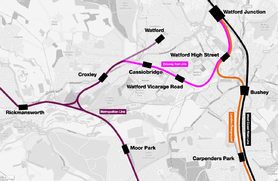
Watford Junction station area improvements
There are plans to upgrade the station and its access points. The scheme includes a new multi-storey car park and a new access road to the station, connecting the A412 to Colonial Way and thus to the A4008 M1 link road.[37]
This scheme is currently in the Pre-Qualification pool, where to achieve funding a case for selection must be submitted and if successful the Watford Station redevelopments will be moved into the Development Pool where more than 24 transport projects will compete for about £600 million.[38]
Croxley Rail Link
A proposal called the Croxley Rail Link - later the Metropolitan Line Extension - would have diverted the Metropolitan line's Watford branch via the disused Croxley Green branch to terminate at Watford Junction. It was expected to open to passenger service in 2020,[39] but due to funding issues, the project has been halted.[40]
Proposed developments
West London Line improvement
The London and South East Route Utilisation Strategy document published by Network Rail in July 2011 makes several suggestions for improving services to and from Watford Junction, to link the West London Line more effectively with the WCML and to 'free up' platform space at London Euston with the anticipation of High Speed 2.[41]
Assuming the ongoing increase in demand on the orbital route between Watford Junction and the West London Line, a significant increase of peak capacity services is needed, as the current service forms the only link between the Watford Junction and Kensington Olympia corridors. This proposal suggests increasing West London Line – Watford Junction/Milton Keynes Central peak service to three tph and increasing present off peak services from an hour to every 30 minutes as well as suggesting extending Southern trains from 4 car to 8 car to help ease overcrowding further.[41]
Crossrail
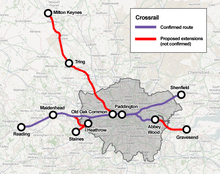
The 2011 London & South East Rail Utilisation Strategy also made recommendations for the Crossrail lines now under construction in central London to be extended northwards into Hertfordshire via Watford Junction, with Tring and Milton Keynes identified as potential termini.[42] The report recommends the addition of a tunnel in the vicinity of a proposed station at Old Oak Common connecting the Crossrail route to the West Coast Main line. The diversion of rail services through central London would enable a direct link from stations such as Watford Junction to West End stations such as Tottenham Court Road and would alleviate congestion at Euston station; Crossrail services currently planned to terminate at Paddington due to capacity constraints would also be able to continue further east, allowing for a more efficient use of the line. This proposal has not been officially confirmed or funded, although an announcement made in August 2014 by the transport secretary Patrick McLoughlin indicated that the government was actively evaluating the possibility of extending Crossrail as far as Tring and Milton Keynes Central.[36]
London Euston/Watford-Aylesbury services
The rail operator Chiltern Railways proposed in 2008 that a new east–west direct rail route from Watford Junction to Aylesbury could be operated via the new Croxley Rail Link and the northern section of the London to Aylesbury Line.[43] The proposal, or a connection from Aylesbury to London Euston, has been supported by the transport advocacy group Greengauge 21.[44] A 2006 report by Hertfordshire County Council mentioned the possibility of a link running as far as Amersham.[45]
Watford to St Albans Busway (Abbey Busway)
A Draft Rail Strategy consultation published by Hertfordshire County Council in June 2015 again considered light rail proposals for the Abbey Line but also recommended that the railway track be removed and replaced with a guided busway.[46][47]
See also
- Watford Underground station (Metropolitan line)
- Watford High Street (Watford DC Line)
- St Albans Branch Line
References
Notes
- "London and South East" (PDF). National Rail. September 2006. Archived from the original (PDF) on 6 March 2009.
- "Station usage estimates". Rail statistics. Office of Rail Regulation. Please note: Some methodology may vary year on year.
- Butt (1995), page 242
- "Network Rail Sectional Appendix Archives - London North Western Southern Section" (PDF). Network Rail.
- Roscoe, Thomas; Lecount, Peter (1839). The London and Birmingham railway, with the home and country scenes on each side of the line. Charles Tilt. pp. 53–54. Retrieved 16 April 2015.
- "The original Watford station". North Watford History Group. Archived from the original on 13 April 2015. Retrieved 13 April 2015.
- "Nationally Listed Buildings in Watford". Watford Borough Council. p. 103. Archived from the original on 6 March 2012. Retrieved 13 April 2015.
- "Bakerloo Line Facts". Transport for London. Archived from the original on 2 May 2007.
- Longman Dictionary https://www.ldoceonline.com/dictionary/north-of-watford
- Birmingham Daily Post, 8 May 1967
- Birmingham Daily Post, 29 December 1970
- Liverpool Echo, 1 January 1972
- Brandon Robshaw,"North of Watford Gap" 2017 https://brandonrobshaw.wordpress.com/2017/08/07/north-of-watford-gap/
- Manchester Evening News, 23 May 1949
- Staffordshire Sentinel, 7 November 1950
- Birmingham Daily Gazette, 4 February 1953
- Griffiths, Roger; Smith, Paul (1999). The directory of British engine Sheds and Principal Locomotive Servicing Points: 1. Oxford: Oxford Publishing Co. p. 106. ISBN 0-86093-542-6.
- "Railway". Watford Junction community website. Watford Museum. Retrieved 28 January 2014.
- Wright, Mike (27 January 2014). "London Midland to rethink Watford Junction revamp after drop-off zone complaints". Watford Observer. Retrieved 28 January 2014.
- Earnshaw, Alan (1991). Trains in Trouble: Vol. 7. Penryn: Atlantic Books. p. 34. ISBN 0-906899-50-8.
- McNaughton, Lt Col I K A (16 July 1975). "Report on the Derailment near Watford Junction" (PDF). HMSO. Cite journal requires
|journal=(help) - "Train struck and damaged by equipment cabinet door in Watford Tunnel, 26 October 2014" (PDF). Rail Accident Investigation Branch. Retrieved 1 September 2017.
- "Train derailed in 'landslide' near Watford Junction". BBC News. BBC News Online. 16 September 2016. Retrieved 16 September 2016.
- Ikonen, Charlotte. "Hundreds rescued after train derails at Hunton Bridge, near Watford Junction". Watford Observer. Newsquest. Retrieved 16 September 2016.
- "Presentation to the Station Master". Herts Advertiser. England. 7 May 1898. Retrieved 16 September 2017 – via British Newspaper Archive.
- "Mr. W. Hedge". Herts & Cambs Reporter and Royston Crow. England. 24 July 1908. Retrieved 16 September 2017 – via British Newspaper Archive.
- "It is announced". Exbridge & W. Drayton Gazette. England. 25 October 1929. Retrieved 16 September 2017 – via British Newspaper Archive.
- "New Street Stationmaster". Birmingham Mail. England. 16 March 1943. Retrieved 16 September 2017 – via British Newspaper Archive.
- "Station Master at 23". Nottingham Evening Post. England. 31 March 1944. Retrieved 16 September 2017 – via British Newspaper Archive.
- "For Carlisle". Lancashire Evening Post. England. 29 April 1946. Retrieved 16 September 2017 – via British Newspaper Archive.
- "Former Keswick Station-Master Retires". Penrith Observer. England. 17 April 1951. Retrieved 16 September 2017 – via British Newspaper Archive.
- GB eNRT December 2015 Edition, Tables 60, 65, 66 & 176 (Network Rail)
- Rail Utilisation Strategy, 2011, pp. 150.
- "'Emerging scenario' suggests Crossrail to the West Coast Main Line". Rail. Peterborough. 10 August 2011. p. 8.
- "Crossrail extension to Hertfordshire being considered". BBC News. 7 August 2014. Retrieved 7 August 2014.
- Topham, Gwyn (7 August 2014). "New Crossrail route mooted from Hertfordshire into London". The Guardian. Retrieved 12 August 2014.
- "4.3 Watford Junction Area". Watford Borough Council. Archived from the original on 5 October 2011. Retrieved 25 November 2008.
- Local Transport Today, Issue 557, Page 7
- "Croxley Rail Link update". 17 December 2014.
- "Metropolitan Line Extension: Everything you need to know about the project". Watford Observer.
- "London and South East Route Utilisation Strategy Draft for Consultation" (PDF). Network Rail. December 2011 – July 2011. p. 140. Archived (PDF) from the original on 27 November 2011.
- "London and South East Route Utilisation Strategy Draft for Consultation" (PDF). Network Rail. December 2011 – July 2011. p. 149. Archived (PDF) from the original on 27 November 2011.
- "Chiltern Railways". Rail Saver. Archived from the original on 8 February 2008.
If the Croxley Rail link gets the go ahead from Tfl and Hertfordshire County Council, direct services into Watford junction from Aylesbury will be likely...
- "Capturing the benefits of HS2 on existing lines" (PDF). Greengauge21. 17 February 2011. Archived (PDF) from the original on 13 March 2012.
- Wood, John (March 2006). "Hertfordshire's Local Transport Plan 2006/07 – 2010/1" (PDF). Hertfordshire County Council. p. 22. Archived from the original (PDF) on 27 September 2007.
- Ikonen, Charlotte. "Direct rail link between Watford and St Albans could be ripped up and converted into busway". Watford Observer. Archived from the original on 13 July 2015. Retrieved 12 July 2015.
- "Hertfordshire Rail Strategy Draft Rail Strategy consultation". Hertfordshire County Council/Arup. 10 June 2015. pp. 65–67. Archived from the original on 12 July 2015. Retrieved 12 July 2015.
Sources
- Butt, R. V. J. (1995). The Directory of Railway Stations: details every public and private passenger station, halt, platform and stopping place, past and present (1st ed.). Sparkford: Patrick Stephens Ltd. ISBN 978-1-85260-508-7. OCLC 60251199.
- Jowett, Alan (March 1989). Jowett's Railway Atlas of Great Britain and Ireland: From Pre-Grouping to the Present Day (1st ed.). Sparkford: Patrick Stephens Ltd. ISBN 978-1-85260-086-0. OCLC 22311137.
External links
| Wikimedia Commons has media related to Watford Junction railway station. |
- "Watford Locomotive Shed".
- "Redevelopment plans". Archived from the original on 17 January 2016.
- "Abbey Line Community Rail Partnership".
- "Public transport in Watford". Archived from the original on 28 September 2007.
